An article by Quintin Watt, Approx. reading time of 6 minutes.
The story of the High Green Lamp, or Gas Pillar, lasted a little over twenty years. The Wolverhampton Gas Company (WGC) was established in 1819 and the town was first lit by gas lamps in 1820. To commemorate this event and to illuminate the market place on High Green (now Queens Square), the WGC built the huge lamp. Built on the site of the old market cross, the Gas Pillar was about 45 feet tall. According to Steen & Blacket’s Wolverhampton Guide and Visitor’s Handbook, it was “a huge iron Corinthian pillar, with an immense lantern at its apex.” Its girth was big enough to allow a man to ascend a spiral staircase inside, to light the lamp every night. The Gas Pillar was controversial from the start, because although its light could be seen from as far away as Kingswood Common and Codsall, the Market Place below the pillar remained in near darkness. In effect, the lamp was much like an inland lighthouse, mockingly referred to as ‘The Big Candlestick.’
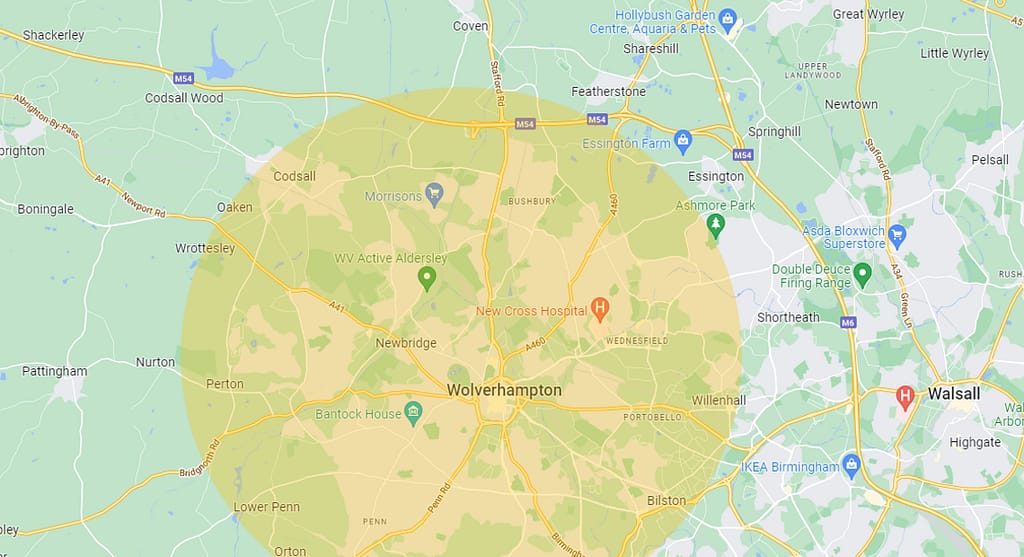
Everyone’s A Critic
Only five years after its erection, the lamp was already attracting critical comment in the local press. One particular resedint wrote to the Wolverhampton Chronicle demanding the pillar’s removal:
“The GAS PILLAR, in its present state, disgraces the public situation in which it is placed, from the filthy and unfinished state of the column, and also the want of palisading around the steps, to prevent their being a lounging place for the most notoriously vicious and dissolute characters of both sexes.”
“A.B.”, the wolverhampton chronicle, august 1826
One suspects the local residents believed the lamp had a metaphorical red light bulb! The following week “A.B.” was supported by “Observator”, who commented that the Gas Committee of the Town Commissioners had already “resolved that it should be taken down; so, why has this not been done?”
The Flame Remains Alight
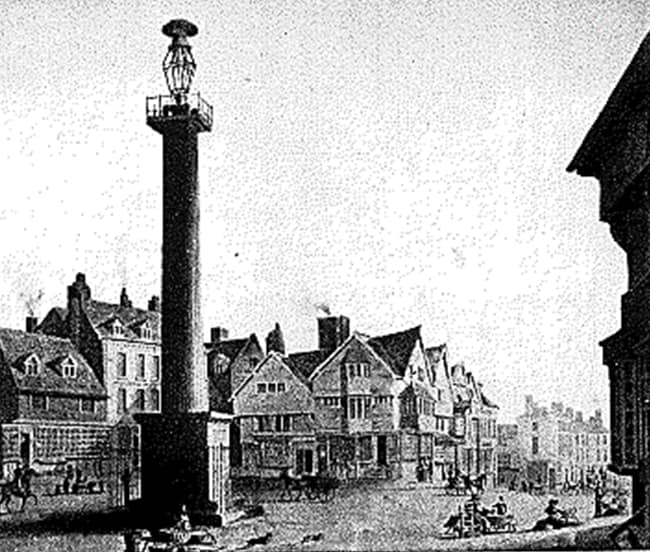
An alternate view of the pillar. The entrance to Darlington Street is on the right.
In spite of these complaints, the Gas Pillar enjoyed a stay of execution for nearly fifteen years, when the condition of the High Green came under the scrutiny of the Town Commissioners. In July 1840, the congested state of the Market Place, with its narrow roads leading to-and-from, made the news. The Commissioners were increasingly concerned about public health hazards and the rubbish in the streets around the foot of the Gas Pillar. At a meeting in June, “the annoyances and obstructions to which the inhabitants were subjected”, were described as “intolerable.” The footway from the Swan Inn to the corner of Lichfield Street was often “crowded with hawkers of tin pots and oranges. Vegetables and fruit baskets were also placed on the curbs and this nuisance has greatly increased.” Some of the hucksters were accused of bringing extra baskets full of straw just to “monopolise the ground” and “prevent competition.” From the corner of Lichfield Street to the gates of St. Peter’s church, crockery vendors “so completely blocked up the road that if a funeral came to the church no hearse or mourning coach could possibly get through the crowd up to the gates.”
The report also mentioned that “the infamous language used by the vendors, the noise and outcry they made in selling their goods, was a nuisance to the whole street.” Another commissioner noted that, ”these people put crates and savage dogs on the footpaths, so that it was impossible to get by.” Later in that same Commissioners meeting, the issue of the town’s gas bill of £639 (the equivalent to almost £70,000 today), received from the WGC, was discussed. Several members believed the town’s rate-payers were being short-changed due to the poor service provided by the gas company. “Mr Underhill said there were constant complaints from the consumers; the quality of the gas was bad; and on the Tettenhall Road sometimes one-third of the lamps were never lighted at all, and the other two thirds were only lighted for half the night.”
The Lamp Is Snuffed Out
At the following meeting of the Town Commissioners, in August 1840, the gas issue was still fizzing, but the WGC fought back, accepting their faults but arguing that the service they provided for the people of Wolverhampton was far better than the “old oil system” of lighting.
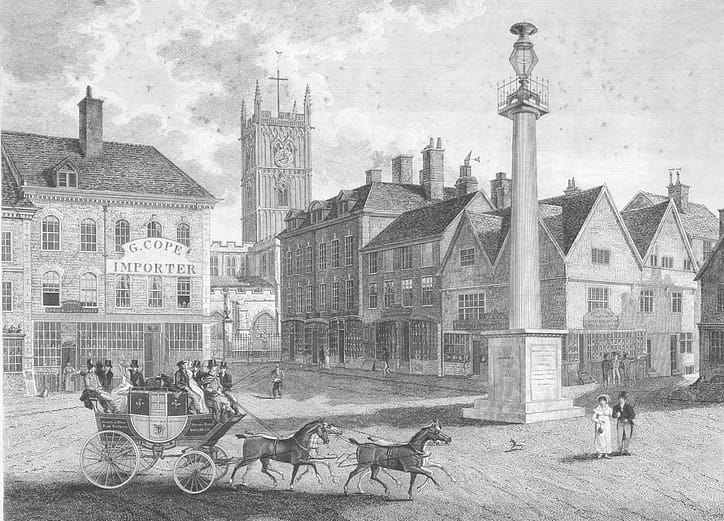
Published in 1824, this image was drawn by John Wessell and shows the view towards Lichfield Street and St Peters.
It appears that this was the moment when the High Green Lamp became the focus for all those critical Commissioners who wanted to clean up the streets as well as the ones who wanted to get their own back on the WGC. Consequently, Mr Sidney submitted a proposal regarding “the desirability of removing the gas pillar, because it was a public nuisance. All the filth of the market was allowed to accumulate about it. It obstructed a free passage and occupied space.” It was also calculated that the annual cost of lighting the pillar was an astonishing £36. So, it was unanimously agreed that the gas pillar should be demolished and “common lamps be placed in the market place in lieu of it.” The decision to demolish the lamp was taken in August 1840, but the pillar itself hung around for a while longer.
An Alternative Proposal
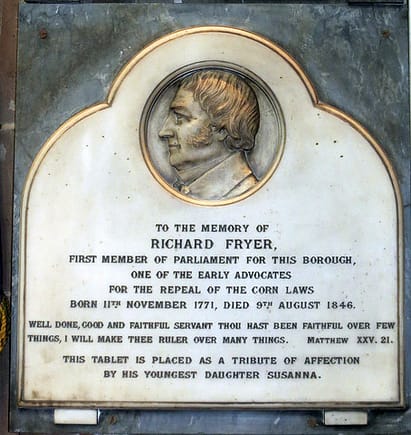
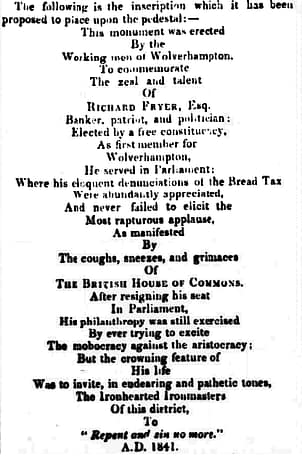
Left, A plaque to Richard Fryer MP in St Peter's Church and Right, A proposed tribute utilising the remaining gas pillar.
In November 1841, a letter received by the Chronicle from “A Sufferer From the Bread Tax” asked for a statue to be erected to the town’s first MP, Richard Fryer. Purported to be from a working man, the letter advocated for a bronze statue of Wolverhampton’s first MP, Richard Fryer, to be erected atop the remaining gas pillar. Fryer was a banker and businessman, but also held philanthropic views, and in the view of the writer supported “the mobocracy against the aristocracy”. It is not clear whether this proposal ever attracted any significant attention and the prvenance of its attribution appears a little dubious. At the best case scenario, it would seem that someone of a more learned persuasion “ghostwrote” the letter, given its rather flowery tributes to Mr Fryer.
Ultimately, the pillar would be demolished, although it is not clear from newspaper archives when this actually occurred. On reflection, the infamous High Green Lamp appears to have become the scapegoat for traffic congestion in the market place, public health concerns about rubbish in the streets, as well as the protracted dispute about Wolverhampton’s gas bill! As a highly visible target for angry rate-payers and town commissioners, Wolverhampton’s flaming gas beacon was finally snuffed out after illuminating the town for only twenty years.
This article first appeared in the Wolverhampton history magazine, The Wolverhampton Lamp, in 2016. With this magazine now out of print, this article is published online for the first time with a slight addendum to the original text.
Quintin Watt, Vice-Chair, The Museum of Wolverhampton and South Staffordshire Trust and former Editor of The Wolverhampton Lamp
Sources Used:
- Steen and Blackett’s, ‘Wolverhampton Guide and Visitors Handbook’, 1871.
- The Wolverhampton Chronicle, 2nd August 1826
- Ibid, 9th August 1826
- Ibid, 1st July 1840
- Ibid, 12th August 1840
- Ibid, 24th November 1841
Want to Learn More?
If this has whet your appetite for more history content, why not come to one of our live events? Details of all our events can be found on our Eventbrite page below.
